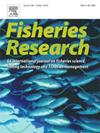An alternative bait for the American lobster fishery composed of fishery by-products to reduce reliance on forage fish
IF 2.2
2区 农林科学
Q2 FISHERIES
引用次数: 0
Abstract
Crustaceans are the subject of valuable, large-scale fisheries around the globe and landings of crustaceans have increased in recent decades. Most crustacean fisheries use traps baited with forage fish that are specifically harvested for the bait market, creating volatility in bait price and placing pressure on forage fish stocks which are critical to broader ecosystem function. The creation of alternative baits that utilize fishery byproducts could therefore increase the economic viability of critical fisheries and reduce pressure on forage fish stocks. Here, we present a transdisciplinary case study in the development of an alternative bait for the American lobster — (Homarus americanus) fishery. Specifically, we formulated an alternative bait composed of ground fish racks (e.g. the remains of commercial fish filleting operations) and hydrolysated, organic fish fertilizer (Neptune’s Harvest©) suspended in a carrageenan-based gel. Field trials under commercial conditions revealed that the best performing alternative prototype captured 53 % as many lobster as traditional bait (Atlantic herring, Clupea harengus). Considering current bait costs, our prototype could prove an economically and ecologically sustainable alternative to traditional forage fish baits. Furthermore, the carrageenan-based formulation could be useful as a liquid attractant delivery system in various crustacean fisheries globally.
美国龙虾渔业的一种替代饵料,由渔业副产品组成,以减少对饲料鱼的依赖
甲壳类动物是全球有价值的大规模渔业的主题,近几十年来,甲壳类动物的上岸数量有所增加。大多数甲壳类渔业使用以饲料鱼为诱饵的陷阱,这些饲料鱼是专门为饵料市场捕捞的,造成饵料价格波动,并对饲料鱼种群造成压力,而饲料鱼种群对更广泛的生态系统功能至关重要。因此,制造利用渔业副产品的替代鱼饵可以增加关键渔业的经济生存能力,并减少对饲料鱼类的压力。在这里,我们提出了一个跨学科的案例研究,在发展替代诱饵的美国龙虾渔业- (Homarus americanus)。具体来说,我们配制了一种替代饵料,由磨碎的鱼架(例如商业鱼片作业的残留物)和水解的有机鱼肥(Neptune’s Harvest©)组成,悬浮在以卡拉胶为基础的凝胶中。在商业条件下进行的实地试验表明,表现最好的替代原型捕获的龙虾数量是传统诱饵(大西洋鲱鱼、海鲱)的53% %。考虑到目前的鱼饵成本,我们的原型可以证明是传统饲料鱼饵的经济和生态可持续的替代品。此外,以卡拉胶为基础的配方可以作为液体引诱剂输送系统在全球各种甲壳类渔业中有用。
本文章由计算机程序翻译,如有差异,请以英文原文为准。
求助全文
约1分钟内获得全文
求助全文
来源期刊

Fisheries Research
农林科学-渔业
CiteScore
4.50
自引率
16.70%
发文量
294
审稿时长
15 weeks
期刊介绍:
This journal provides an international forum for the publication of papers in the areas of fisheries science, fishing technology, fisheries management and relevant socio-economics. The scope covers fisheries in salt, brackish and freshwater systems, and all aspects of associated ecology, environmental aspects of fisheries, and economics. Both theoretical and practical papers are acceptable, including laboratory and field experimental studies relevant to fisheries. Papers on the conservation of exploitable living resources are welcome. Review and Viewpoint articles are also published. As the specified areas inevitably impinge on and interrelate with each other, the approach of the journal is multidisciplinary, and authors are encouraged to emphasise the relevance of their own work to that of other disciplines. The journal is intended for fisheries scientists, biological oceanographers, gear technologists, economists, managers, administrators, policy makers and legislators.
 求助内容:
求助内容: 应助结果提醒方式:
应助结果提醒方式:


